STATUETTE DE HAYAGRIVA EN ARGENT ET ALLIAGE DE CUIVRE DORÉTIBET, VERS XVIIE SIÈCLE Himalayan Art Resources item no. 205049 10 cm (4 in.) highFootnotesA SILVER AND GILT COPPER ALLOY FIGURE OF HAYAGRIVA TIBET, CIRCA 17TH CENTURY 西藏 約十七世紀 銅嵌寶銀手杖馬頭明王像 This elaborate gilt-bronze represents a meditational deity (yidam) rarely seen in Tibetan sculpture known as Black Hayagriva, identified by the horse's head emerging behind the crown and notably, for his layered silk robe. Remarkable for its liveliness and depth of composition, this figure was likely intended to be placed within a gau, or a shrine inside a home or temple for personal worship. Due to its individualized rendering, this Hayagriva falls into a category of gilt-bronzes that do not follow a homogenous artistic tradition and as a consequence, comparable examples are often dated conservatively to later periods. That being said, certain stylistic elements, such as the flaming mandorla and the manner in which the trampled figures nearly spill over the edge of the base, point to a 17th century dating. See a possibly earlier gold figure of Yamantaka, sold at Christie's, New York, 15 March 2016, lot 246, together with a larger 17th-century image of Chakrasamvara from the Claude de Marteau Collection, sold at Bonhams, Paris, 4 October 2022, lot 36. A close comparison can also be seen in a larger Raktayamari in the British Museum (Ramos Tantra, 2020, p. 1135, fig. 96) that is dominated by turquoise inlay, similar treatment of the lotus petals, and the figure brandishes a silver shaft club. Also compare the incised visvavajra located at the base of the figure, which relates closely to a 17th century portrait image depicting the Fifth Sharmapa in gilt-silver, sold at Bonhams, Hong Kong, 30 November 2022, lot 1017. As for attribution, Hayagriva's fluttering shirtsleeves, the compressed treatment of his stomach, the shallow relief of his robe, and the wide, archaistic style of the lotus petals correlate to Eastern Tibetan images. This is further supported by the use of silver for Hayagriva's weapons, as the foundries of the Derge Kingdom were highly sought after for their skill in metalwork. Compare with a small gilt-bronze of Kubera with large turquoise insets (published in Berger Mongolia: The Legacy of Chinggis Khan, 1995, p. 233, no. 77). Lastly, see an image of King Gesar with similar shirtsleeves, sold at Bonhams, New York, 13 March 2017, lot 3094, together with a portrait image of Gampopa with archaic lotus petal designs and clothing in shallow relief, sold at Bonhams, New York, 14 March 2017, lot 3226. Provenance: Ashencaen and Leonov, London, 2000sSaleroom noticesVeuillez noter que le titre chinois a été mis à jour. Veuillez vous référer à l'avis en chinois. / Please note that Chinese title of this lot has been updated, please refer to Chinese saleroom notice. / 敬請注意,本拍品名稱應爲「銅鎏金嵌寶銀手杖馬頭明王像」。
STATUETTE DE HAYAGRIVA EN ARGENT ET ALLIAGE DE CUIVRE DORÉTIBET, VERS XVIIE SIÈCLE Himalayan Art Resources item no. 205049 10 cm (4 in.) highFootnotesA SILVER AND GILT COPPER ALLOY FIGURE OF HAYAGRIVA TIBET, CIRCA 17TH CENTURY 西藏 約十七世紀 銅嵌寶銀手杖馬頭明王像 This elaborate gilt-bronze represents a meditational deity (yidam) rarely seen in Tibetan sculpture known as Black Hayagriva, identified by the horse's head emerging behind the crown and notably, for his layered silk robe. Remarkable for its liveliness and depth of composition, this figure was likely intended to be placed within a gau, or a shrine inside a home or temple for personal worship. Due to its individualized rendering, this Hayagriva falls into a category of gilt-bronzes that do not follow a homogenous artistic tradition and as a consequence, comparable examples are often dated conservatively to later periods. That being said, certain stylistic elements, such as the flaming mandorla and the manner in which the trampled figures nearly spill over the edge of the base, point to a 17th century dating. See a possibly earlier gold figure of Yamantaka, sold at Christie's, New York, 15 March 2016, lot 246, together with a larger 17th-century image of Chakrasamvara from the Claude de Marteau Collection, sold at Bonhams, Paris, 4 October 2022, lot 36. A close comparison can also be seen in a larger Raktayamari in the British Museum (Ramos Tantra, 2020, p. 1135, fig. 96) that is dominated by turquoise inlay, similar treatment of the lotus petals, and the figure brandishes a silver shaft club. Also compare the incised visvavajra located at the base of the figure, which relates closely to a 17th century portrait image depicting the Fifth Sharmapa in gilt-silver, sold at Bonhams, Hong Kong, 30 November 2022, lot 1017. As for attribution, Hayagriva's fluttering shirtsleeves, the compressed treatment of his stomach, the shallow relief of his robe, and the wide, archaistic style of the lotus petals correlate to Eastern Tibetan images. This is further supported by the use of silver for Hayagriva's weapons, as the foundries of the Derge Kingdom were highly sought after for their skill in metalwork. Compare with a small gilt-bronze of Kubera with large turquoise insets (published in Berger Mongolia: The Legacy of Chinggis Khan, 1995, p. 233, no. 77). Lastly, see an image of King Gesar with similar shirtsleeves, sold at Bonhams, New York, 13 March 2017, lot 3094, together with a portrait image of Gampopa with archaic lotus petal designs and clothing in shallow relief, sold at Bonhams, New York, 14 March 2017, lot 3226. Provenance: Ashencaen and Leonov, London, 2000sSaleroom noticesVeuillez noter que le titre chinois a été mis à jour. Veuillez vous référer à l'avis en chinois. / Please note that Chinese title of this lot has been updated, please refer to Chinese saleroom notice. / 敬請注意,本拍品名稱應爲「銅鎏金嵌寶銀手杖馬頭明王像」。


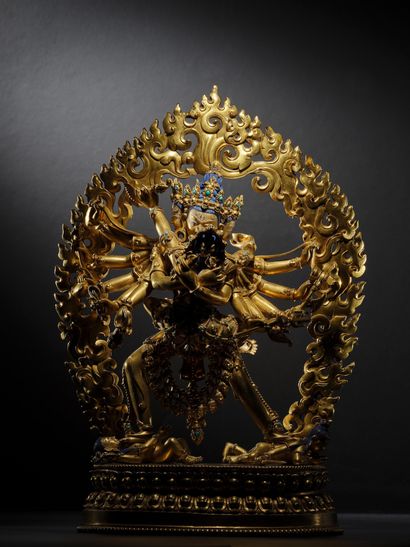

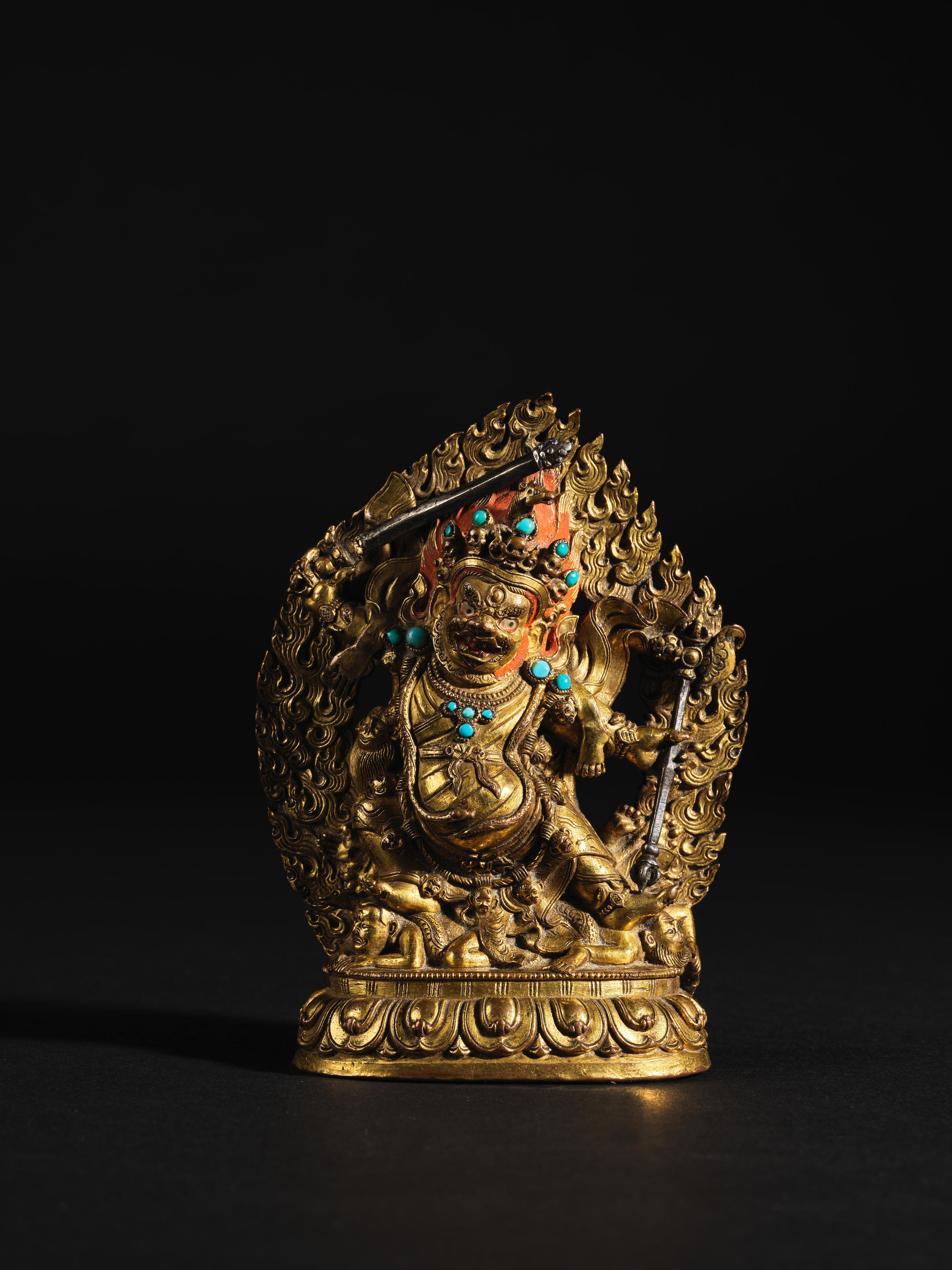







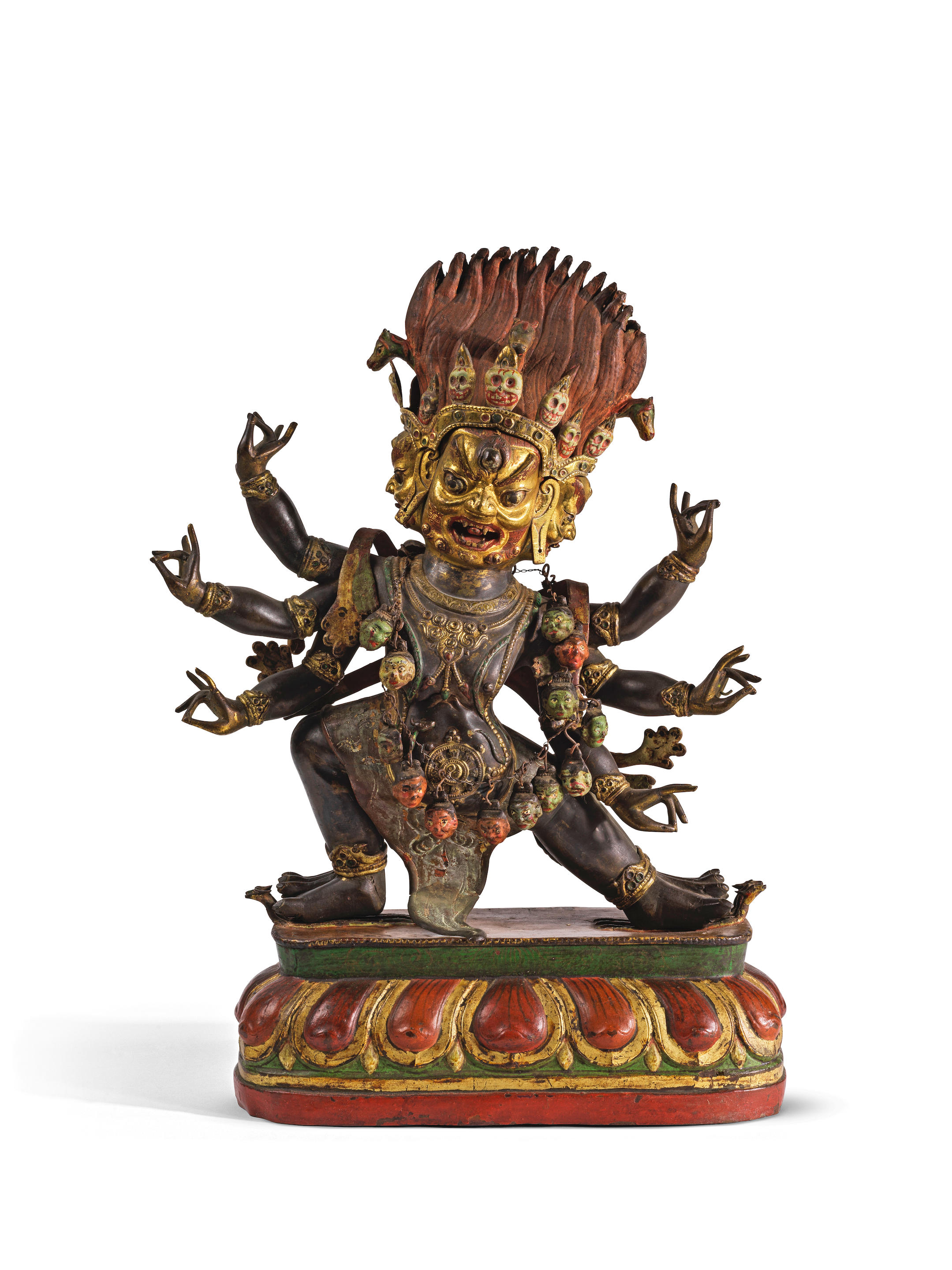
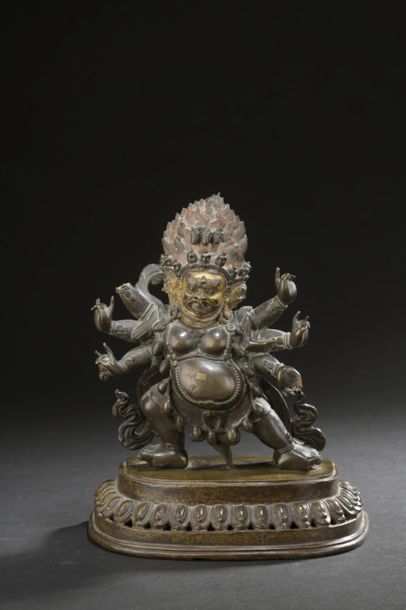
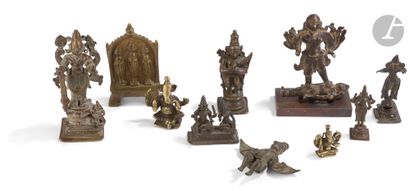
Testen Sie LotSearch und seine Premium-Features 7 Tage - ohne Kosten!
Lassen Sie sich automatisch über neue Objekte in kommenden Auktionen benachrichtigen.
Suchauftrag anlegen